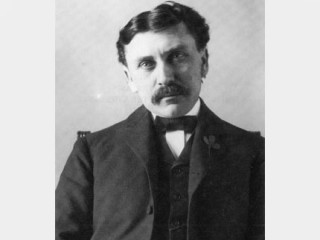
James Mooney biography
Date of birth : 1861-02-10
Date of death : 1921-12-22
Birthplace : Richmond, Indiana
Nationality : American
Category : Arhitecture and Engineering
Last modified : 2010-10-05
Credited as : Anthropologist, works on Native American Indians,
2 votes so far
Life
James Mooney was born February 10, 1861 in Richmond, Indiana, into a family of Irish immigrants. His father, James Mooney, died soon after Mooney’s birth, and so Mooney’s mother, Ellen Devlin, had to raise her son alone. James graduated from high school in 1878, and taught at a public school for one year, after which he joined the staff of Richmond Palladium.
Mooney became interested in American Indians as a child, and started studying their culture as a hobby. In 1884 he tried (unsuccessfully) to obtain employment at the Smithsonian Institution's Bureau of Ethnology (later the Bureau of American Ethnology). However, the mayor of Richmond sent a letter to John Wesley Powell, the director of the Smithsonian, in which he introduced Mooney as a “devoted anthropologist,” and, in 1885, when Powell saw the work Mooney had done in compiling a dictionary of tribal names and their synonyms, Mooney was hired.
He moved to Washington, D.C. and married Ione Lee Gaut in 1897, with whom he had six children.
Mooney started his field studies among the Cherokee in 1887. He spent several years in this research, which led to the publication of his seminal works: Sacred Formulas of the Cherokees (1891), Myths of the Cherokee (1900), and The Swimmer Manuscript: Cherokee Sacred Formulas and Medicine Prescriptions (1932). These publications are regarded as some of the best records of Cherokee culture ever compiled.
In late 1890, while visiting Indian Territory, Mooney witnessed the Ghost Dance—the religious ritual that became a center of the messianic religious movement among Native Americans in the 1890s. Mooney spent three years in study of this social phenomenon, publishing his findings in The Ghost Dance Religion and the Sioux Outbreak of 1890 in 1896. This work is considered a masterpiece, and earned Mooney fame among fellow scholars.
Mooney continued to work among Kiowa and Comanche Indians throughout 1890s, compiling his second greatest work, The Calendar History of the Kiowa Indians, in 1898. Mooney explained that the calendar recorded Kiowa’s pictographic art, which represented a history of their tribe, thus demonstrating the falsity of the belief that Native Americans are people without a written history.
Mooney spent next the twenty years in studying the Peyote Religion. His support for the use of peyote in religious practices, however, drew negative attention to his work. In 1918, he assisted in the chartering of the Native American Church of Oklahoma, an act that ignored federal attempts to ban peyote. The Secretary of the Interior issued a ban on Mooney’s research, which Mooney unsuccessfully tried to lift for the remainder of his career. He died in his home in Washington D.C. in 1921.
Work
Mooney started his study of American Indians as a hobby, but his passion for them later turned into a long and successful career. As a young man he compiled a list containing three thousand tribal names and their synonyms, which was eventually published in the Handbook of American Indians North of Mexico (Hodge 1907). After he started work at the Smithsonian, his dream came true and Mooney soon became an expert on Native American culture.
Mooney was greatly influenced by Washington Matthews, curator of the Army Medical Museum, and Mooney’s personal tutor at the Smithsonian. He taught Mooney that in order to understand Indian culture, one has to become totally immersed in it. Mooney, therefore, learned to speak Cherokee, Kiowa, and Comanche, and lived with the tribes he studied.
Mooney became famous due to his research on the Ghost Dance movement. Living among the Cherokee, Mooney observed conflict between traditional Indian culture and the culture of the white man. He witnessed the resistance toward forceful assimilation, especially exhibited by some shamans and traditional healers. When in the 1890s the Ghost Dance movement swept across the United States, uniting numerous Indian tribes under the common denominator of nonviolent resistance to Euro-American expansion, Mooney became an advocate for the Indian cause. Through his writings he tried to present Indian culture in a light understandable to a white man. He even made comparisons in his writings between the Ghost Dance and other religions, including Christianity, trying in that way to bridge the gap between the cultures.
Legacy
Mooney’s study on the Ghost Dance movement has been regarded as his greatest work. It was the first accurate, historical account of the movement, and was later used by generations of anthropologists as a source of background information about the Sioux rebellion.
Regarding methodology, Mooney can be considered one of the true pioneers of ethnological research. His immersion into the Indian culture led him to not only understand it, but also to become a significant advocate for the Indian cause. Unfortunately, however, his immersion in the culture was rather too complete, and he lost effectiveness as their advocate over his insistence on continuing the use of peyote although it was banned by the government.
















